
[Christopher Sopher is a senior at the University of North Carolina, where he is a Morehead-Cain Scholar and a Truman Scholar. He has been a multimedia editor of the Daily Tar Heel and has worked for the Knight Foundation. His studies have focused on young people’s consumption of news and participation in civic life — which have resulted in both a formal report and an ongoing blog, Younger Thinking.
We asked Chris to adapt some of his most relevant findings for the Lab, which he kindly agreed to do. Below is Part 1; we’ll post Part 2 tomorrow. —Ed.]
 There are three “truths” the journalism world seems to acknowledge about the current generation of young people: They like cell phones, they use Facebook, and they never read newspapers. This is frequently interpreted to mean the end of the storied twentieth century tradition of reading the newspaper at the breakfast table, and, therefore, the end of democracy.
There are three “truths” the journalism world seems to acknowledge about the current generation of young people: They like cell phones, they use Facebook, and they never read newspapers. This is frequently interpreted to mean the end of the storied twentieth century tradition of reading the newspaper at the breakfast table, and, therefore, the end of democracy.
Perhaps it’s youthful naivete, but I’m fairly certain there are a few steps between reading the news on a mobile phone and the inability of a people to govern themselves. And this isn’t the first time a generation of young people has been accused of marching the world toward languid doom. The question that matters is this: What will replace the morning newspaper as the news habit of the first generation of Americans to grow up immersed in a digital culture? I recently finished a year of research and review in an attempt to find some answers to this question.
What I found was this:
With a few exceptions, the journalism world hasn’t been particularly effective at connecting its concern about young audiences to better understanding or better action. Which is an unfortunate failure, because young people have a lot to teach — both about themselves as current and future news consumers, and about the social and technological trends that shape the news ecosystem.
The broad summary is that most of today’s young people (the “millennials”) are interested in local, national, and international issues — and a strong majority are at least somewhat engaged with news media, predominantly online, through social networks and on television. Yet there is also great untapped potential resulting from the troublesome fact that most news outlets simply aren’t very good at reaching or serving young audiences.
 Without significant changes and experimentation, news organizations are likely to miss the democratic, journalistic, and financial opportunities that are latent in the largest generation since the Baby Boomers. It is a common-sense but regrettably neglected point: If you care about the future of news, you need to care about (and understand) young people.
Without significant changes and experimentation, news organizations are likely to miss the democratic, journalistic, and financial opportunities that are latent in the largest generation since the Baby Boomers. It is a common-sense but regrettably neglected point: If you care about the future of news, you need to care about (and understand) young people.
At the conclusion of my research, I compiled a list of the ten ideas I believe hold the most promise for getting more young people engaged with the news media. The general theme is that news organizations need to create a more usable, relevant, and explanatory experience and combine it with serious support for news literacy and news-in-schools programs that communicate to young people why they ought to use and support journalism. These aren’t complex or novel ideas individually, but if they’re to be effective, they’ll need collective attention.
I’ll explore a few of the most pertinent ideas in more detail in the next post, but I’ll conclude here with three points I think are vital to understanding young people’s relationship with the news.
1. The cliche that becomes the assumption. Too many stereotypes about young people get worked into news experiments aimed at them. One example: while it’s true that most young people feel more comfortable with technology and the Internet than their elders do, we don’t possess some sherpa-like, innate ability to navigate poorly designed, poorly organized information (as the Media Management Center’s excellent research demonstrates). Recreating an old experience in a new format is an ineffective way to reach young audiences.
2. Boring or fluffy. Most sectors of journalism thought have rejected the bimodal theory of news: either it’s inherently boring but deeply important (town council minutes) or entertaining but inane (Lindsey Lohan updates). Yet for some reason the assumption of bifurcation continues to pervade news outlets’ discussion of young people: Journalist types implore young people to eat more broccoli, while most news organizations’ efforts to reach young people assume they’re only interested in candy. (See Chicago’s RedEye or Denver’s failed 2005 experiment, Bias Magazine.) The potential is in the elusive middle ground — which I suppose, to follow my own analogy, would be “tasty vegetables.”
3. Why young people get the news. It’s an obvious, but often overlooked, point that the news needs to be designed with an awareness of how and why the audience experiences it. As for the latter, there are many theories about why young people read the news (and some excellent research, such as this ethnographic study [pdf] by the AP): the social capital theory (also known as “I want to seem smart by being able to talk about the oil spill’s effects on the brown pelican”); the democracy theory; the habit theory. The truth is probably a combination of these three, but they all point to the idea that news is both social and functional. Most news organizations do a poor job of providing an experience that, for young audiences — who have a different level of knowledge and experience than older consumers — is either of those things.
The point: Journalism needs to focus on young audiences and experiment with new approaches to engaging them. The results of that would be beneficial for everyone involved. Here, again, is my list of ten ideas for making it happen. What would you add?
Image of a paper-reader by foreverphoto, used under a Creative Commons license.